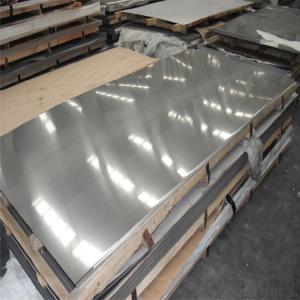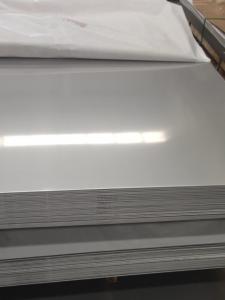Stainless Steel Sheets 2B Finish Grade 201 Stainless Steel Sheets
- Loading Port:
- Shekou
- Payment Terms:
- TT OR LC
- Min Order Qty:
- 25 m.t.
- Supply Capability:
- 20000 m.t./month
OKorder Service Pledge
OKorder Financial Service
You Might Also Like
Specification
Products Description for Stainless Steel Coils/Sheets:
Product | stainless steel coils/plates/sheets | ||
Discharge Port | Any Port, China | ||
Size | Coils | Cold Rolled: | Thickness0.3-8mm,Width:280-2100mm |
Hot Rolled : | Thickness3-14mm,Width:650-2100mm | ||
Plates | Thickness2-80mm,Width:1500-3000mm | ||
Coil Weight | About 20 Tons | ||
Grade | 201,202,304/304L/304H,316/316L/316H,321/H,310S,409/L,430 etc. | ||
Technique | Hot Rolled/Cold Rolled | ||
Finish | 2B, BA, 2D, No1, No2, No4,NO.8,SB etc | ||
Edge | Mill Edge / Slitting Edge | ||
Package | In bundles, or as customer's requirement | ||
Place of Origin | Made in China | ||
MOQ | 20 Tons | ||
Technical notes:
Surface Finish | Definition | Application |
2B | Those finished, after cold rolling, by heat treatment, pickling or other equivalent treatment and lastly by cold rolling to given appropriate luster. | Medical equipment, Food industry, Construction material, Kitchen utensils. |
BA | Those processed with bright heat treatment after cold rolling. | Kitchen utensils, Electric equipment, Building construction. |
NO.3 | Those finished by polishing with No.100 to No.120 abrasives specified in JIS R6001. | Kitchen utensils, Building construction. |
NO.4 | Those finished by polishing with No.150 to No.180 abrasives specified in JIS R6001. | Kitchen utensils, Building construction, Medical equipment. |
HL | Those finished polishing so as to give continuous polishing streaks by using abrasive of suitable grain size. | Building Construction. |
Packaging & Delivery for Stainless Steel Coils/Sheets:
Packaging Detail | Standard export packing or following customer's demand |
Delivery Time | Within 30-40 days after deposit or according to the order quantity |
Detail picture for Stainless Steel Coils/Sheets


Application for Stainless Steel Coils/Sheets:
Boiler heat exchanger, machinery andpetroleum ,chemical industries, hardware fields,Food industry,construction material,kitchen utensils, building construction, medical equipment,chemical tank, pipe etc
Payment&Delivery for Stainless Steel Coils/Sheets:
Payment Terms | 100% LC at sight,or 30%TT in advance, balance against B/L copy |
Delivery Time | With 30-40 days after deposit |
Price Terms | Ex-Work, FOB, CNF, CFR, CIF,etc |
FAQ for Stainless Steel Coils/Sheets:
Q:What are the advantages of your company ?
A: We have many professionals, technical personnel, more competitive prices and best after-dales service than other stainless steel companies.
Q:Can you arrange the shipment ?
A: Sure we can help you with the shipment. We have forwarders who have cooperated with us for many years.
- Q: What are the factors to consider when selecting the right grade of stainless steel sheet?
- There are several considerations to keep in mind when choosing the appropriate grade of stainless steel sheet. Firstly, it is crucial to understand the intended application of the sheet. Different grades of stainless steel offer varying levels of corrosion resistance, strength, and temperature resistance. Therefore, it is important to assess the specific requirements of the application, such as exposure to corrosive environments or high temperatures. Additionally, the desired appearance and finish of the sheet should be taken into account. Some grades of stainless steel are more suitable for achieving a polished or mirror-like finish, while others are better suited for a brushed or matte appearance. Certain grades may also be more resistant to scratching or showing fingerprints, which is important in applications where aesthetics are a priority. Cost is another significant factor to consider. Prices for different grades of stainless steel can vary significantly, depending on factors such as the alloying elements used and the manufacturing process. It is essential to strike a balance between the desired properties and performance of the sheet and the available budget. The ease of fabrication and welding is also a critical factor. Some grades of stainless steel are more easily machinable and formable, making them better suited for certain fabrication processes. Similarly, certain grades have better weldability, which is important in applications where welding is required. Lastly, the availability and sourcing of the selected grade should be considered. Certain grades of stainless steel may be more readily available in specific regions or from certain suppliers. Ensuring that the selected grade can be easily sourced is important to avoid delays or increased costs in the supply chain. In conclusion, when choosing the appropriate grade of stainless steel sheet, careful consideration should be given to factors such as the intended application, desired appearance, cost, ease of fabrication and welding, and availability. By evaluating these factors, one can make an informed decision and select the most suitable grade of stainless steel sheet for their specific requirements.
- Q: Are stainless steel sheets suitable for structural applications?
- Stainless steel sheets, indeed, prove to be appropriate for structural applications. This material, known for its versatility and durability, boasts a remarkable strength-to-weight ratio, rendering it highly suitable for diverse structural purposes. Its exceptional corrosion resistance is particularly vital for structures subjected to severe environmental conditions or chemical exposure. Utilizing stainless steel sheets in the fabrication of bridges, buildings, and other structural elements ensures the attainment of necessary robustness and longevity. Moreover, stainless steel stands as a sustainable choice due to its complete recyclability, thereby further augmenting its appropriateness for structural applications.
- Q: What is the bending strength of stainless steel sheets?
- The bending strength of stainless steel sheets can vary depending on the specific grade and thickness of the sheet. However, stainless steel is generally known for its high strength and rigidity, making it suitable for various applications that require strong and durable materials.
- Q: Are stainless steel sheets resistant to chlorine?
- Yes, stainless steel sheets are generally resistant to chlorine. Stainless steel is known for its corrosion resistance properties, and it can withstand exposure to chlorine without significant degradation. This makes stainless steel sheets a suitable choice for applications in chlorinated environments such as swimming pools, water treatment plants, and chemical processing facilities. However, it is important to note that prolonged exposure to high concentrations of chlorine or certain chemicals can still cause some corrosion or discoloration on stainless steel surfaces. Regular maintenance and proper cleaning procedures can help maintain the longevity and appearance of stainless steel sheets in chlorinated environments.
- Q: Are stainless steel sheets suitable for heat transfer equipment?
- Yes, stainless steel sheets are indeed suitable for heat transfer equipment. Stainless steel has excellent thermal conductivity, which allows for efficient heat transfer. It also has high corrosion resistance and can withstand high temperatures, making it a reliable choice for various heat transfer applications.
- Q: Are stainless steel sheets suitable for laboratory equipment or instruments?
- Yes, stainless steel sheets are highly suitable for laboratory equipment or instruments. Stainless steel is known for its excellent corrosion resistance, durability, and high strength, making it an ideal choice for laboratory applications. It is resistant to chemicals, heat, and staining, which ensures the longevity and reliability of the equipment. Additionally, stainless steel is easy to clean and maintain, meeting the strict hygiene standards required in laboratories.
- Q: Are stainless steel sheets suitable for pharmaceutical equipment?
- Yes, stainless steel sheets are highly suitable for pharmaceutical equipment due to their excellent corrosion resistance, hygienic properties, and ease of cleaning. Stainless steel is non-reactive, non-toxic, and can withstand high temperatures, making it ideal for pharmaceutical applications that require strict cleanliness and durability.
- Q: What is the price range for stainless steel sheets?
- The price range for stainless steel sheets can vary depending on factors such as size, thickness, and grade of stainless steel. Generally, stainless steel sheets can range from $20 to $200 per sheet, but prices can be higher for specialized or custom-made sheets.
- Q: Are stainless steel sheets safe for medical applications?
- Yes, stainless steel sheets are safe for medical applications. They are widely used in the medical industry due to their excellent corrosion resistance, biocompatibility, and durability. Stainless steel is easy to clean, sterilize, and maintain, making it suitable for surgical instruments, medical devices, and equipment used in healthcare settings.
- Q: Can stainless steel sheets be used for food processing?
- Yes, stainless steel sheets are commonly used in food processing due to their excellent corrosion resistance, durability, and ease of cleaning. They do not react with food, making them safe for use in various food processing applications such as food preparation surfaces, equipment, and storage containers.
Send your message to us
Stainless Steel Sheets 2B Finish Grade 201 Stainless Steel Sheets
- Loading Port:
- Shekou
- Payment Terms:
- TT OR LC
- Min Order Qty:
- 25 m.t.
- Supply Capability:
- 20000 m.t./month
OKorder Service Pledge
OKorder Financial Service
Similar products
Hot products
Hot Searches
Related keywords




























